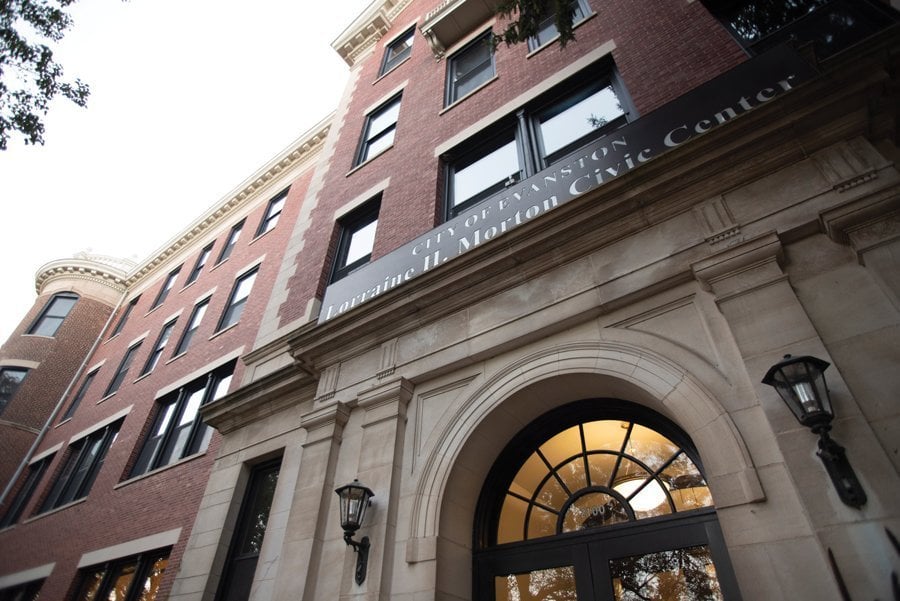Rapid Recap: City Council approves changes to ARPA fund usage plan
Daily file photo by Colin Boyle
The Lorraine H. Morton Civic Center. The Equity and Empowerment Commission released its first survey about racial equity Tuesday.
March 15, 2022
City Council unanimously approved updates to Evanston’s American Rescue Plan Act of 2021 funding plan Monday.
What context should I know here?
ARPA is a $1.9 trillion federal plan meant to help the United States recover from the pandemic’s economic and health effects.
From the $350 billion in ARPA funds meant to aid state, tribal and local governments, the U.S. Department of the Treasury allocated $43 million to Evanston. The city can use these funds to address the pandemic’s economic impact, water, sewer and broadband infrastructure, municipal revenue loss and premium pay.
Evanston received half the funds last May, and will receive the remaining half this May. As of Feb. 28, City Council and its committees had earmarked or are considering earmarking about $22 million for use, leaving about $21 million.
To organize ARPA allocations, the council uses a system of “buckets.” Each bucket addresses a specific purpose and contains a set amount of funding.
Last May, City Council set up 11 buckets: COVID-19 response; ARPA management and compliance; revenue replacement; hazard premium pay; economic development; social services; affordable housing; water and sewer infrastructure; inclusive and equitable recovery; participatory budgeting and reserve.
On Feb. 28, the council considered a motion to realign the buckets with the seven federal ARPA funding categories: public health; negative economic impacts; services to disproportionately impacted communities; premium pay; administration and other; infrastructure and revenue replacement. City Council held the motion and discussed a revised version Monday.
What were the key points of debate?
Both City Council meetings discussed aligning Evanston’s buckets with federal buckets.
Some councilmembers disagreed on the best way to integrate community input on spending. The Feb. 28 proposal incorporated money for participatory budgeting into the seven other buckets. At that City Council meeting, Ald. Devon Reid (8th) recommended creating a separate bucket dedicated to community spending.
“(Let’s say) the community wanted to spend even more on public health,” Reid said. But if the council already capped the public health ARPA bucket, “we cut off in some way that ability to do that.”
Monday’s motion added an eighth bucket specifically for participatory budgeting, allocating $3.5 million to be spent based on community feedback.
Ald. Jonathan Nieuwsma (4th) said Monday he wanted to know how the Climate Action and Resilience Plan could be implemented through ARPA funding.
While all uses of ARPA funding must comply with federally-specified uses, some overlap with CARP goals. In October 2021, about 150 Evanston Township High School students walked out to pressure the council direct ARPA funds toward implementing CARP.
Cara Pratt, Evanston’s sustainability and resilience coordinator, said some CARP programs eligible for ARPA funding include a “one-stop shop” affordable housing program and water infrastructure initiatives.
Councilmembers also discussed how the city’s committees would handle the funding. Federal ARPA categories don’t align neatly with Evanston’s existing committees.
Reid said he would have preferred the buckets and their funding allocations be more reflective of Evanston’s committee structure, to make more clear how much each committee could suggest spending.
Sarah Flax, the city’s housing and grants manager, said Reid’s proposal would be challenging because most of the ARPA categories don’t match up with Evanston’s boards, committees and commissions.
For the time being, Interim City Manager Kelley Gandurski said Flax would decide how to direct projects to committees.
“We had hoped to hire on our ARPA specialist, which we have not been able to do,” Gandurski said. “For now, I would say start with Sarah Flax and staff to guide you … through the right channels.”
What’s the expected impact of the vote?
The vote sets up eight buckets to replace the previous 11. The eight are: public health; negative economic impacts; services to disproportionately impacted communities; premium pay; infrastructure; revenue replacement; administration and other and participatory budgeting.
Each bucket has an associated set dollar amount, which can be found in Economic Development Manager Paul Zalmezak’s memorandum about ARPA planning.
What should I look out for in the future?
City Council still has about $21 million in ARPA funding to disburse. Per federal guidelines, the council must develop a plan to spend all of the funding by December 2024.
Email: [email protected]
Twitter: @avivabechky
Related Stories:
— City Council discusses ARPA priorities, creates Participatory Budgeting Committee in special meeting
— City Council approves 2022 budget after monthslong ARPA fund use debate
— Ald. Devon Reid talks ARPA allocations, public records access


